- Clone
- TX42.1 (See other available formats)
- Regulatory Status
- RUO
- Other Names
- DNAM-1, PTA1 (Platelet and T cell activation antigen 1), TLISA1, LFA-1 associated molecule PTA-1
- Isotype
- Rat IgG2a, κ
- Ave. Rating
- Submit a Review
- Product Citations
- publications

-

C57BL/6 mouse splenocytes were stained with CD8 FITC and CD226 (clone TX42.1) Brilliant Violet 605™ (top) or Rat IgG2a, κ Brilliant Violet 605™ isotype control (bottom). -

| Cat # | Size | Price | Quantity Check Availability | Save | ||
|---|---|---|---|---|---|---|
| 133613 | 50 µg | 243€ | ||||
Mouse CD226 (DNAM-1) is a 65 kd glycoprotein of a member of Ig super-family adhesion molecule containing 2 immunoglobulin-like domains. It is associated with leukocyte function associated antigen-1 (LFA-1) involving in TCR-mediated signal transduction for T cell proliferation and differentiation. CD226 is also involved in NK cell and T cell mediated cytotoxicity against certain tumors. CD226 (DNAM-1) is constitutively expressed on naïve CD8+ and CD4+ T cells, macrophages, and NK cells. It was reported that CD226 expression is up-regulated on Th1 cells, but down-regulated on Th2 and Th0 cells. CD155 and CD112 are the ligands for CD226.
Product DetailsProduct Details
- Verified Reactivity
- Mouse
- Antibody Type
- Monoclonal
- Host Species
- Rat
- Immunogen
- Mouse DNAM-1 transfected cells
- Formulation
- Phosphate-buffered solution, pH 7.2, containing 0.09% sodium azide and BSA (origin USA).
- Preparation
- The antibody was purified by affinity chromatography and conjugated with Brilliant Violet 650™ under optimal conditions.
- Concentration
- 0.2 mg/ml
- Storage & Handling
- The antibody solution should be stored undiluted between 2°C and 8°C, and protected from prolonged exposure to light. Do not freeze.
- Application
-
FC - Quality tested
- Recommended Usage
-
Each lot of this antibody is quality control tested by immunofluorescent staining with flow cytometric analysis. For flow cytometric staining, the suggested use of this reagent is ≤0.5 µg per million cells in 100 µl volume. It is recommended that the reagent be titrated for optimal performance for each application.
Brilliant Violet 650™ excites at 405 nm and emits at 645 nm. The bandpass filter 660/20 nm is recommended for detection, although filter optimization may be required depending on other fluorophores used. Be sure to verify that your cytometer configuration and software setup are appropriate for detecting this channel. Refer to your instrument manual or manufacturer for support. Brilliant Violet 650™ is a trademark of Sirigen Group Ltd.
Learn more about Brilliant Violet™.
This product is subject to proprietary rights of Sirigen Inc. and is made and sold under license from Sirigen Inc. The purchase of this product conveys to the buyer a non-transferable right to use the purchased product for research purposes only. This product may not be resold or incorporated in any manner into another product for resale. Any use for therapeutics or diagnostics is strictly prohibited. This product is covered by U.S. Patent(s), pending patent applications and foreign equivalents. - Excitation Laser
-
Violet Laser (405 nm)
-
Application References
(PubMed link indicates BioLegend citation) -
- Dardalhon V, et al. 2005. J. Immunol. 175:1558
- Shirakawa J, et al. 2006. International Immunology 18(6):951-957
- Product Citations
-
- RRID
-
AB_2715976 (BioLegend Cat. No. 133613)
Antigen Details
- Structure
- 65 kd glycoprotein of a member of Ig super-family containing 2 immunoglobulin-like domains.
- Distribution
-
Expressed on majority of CD8+ and CD4+ T cells, NK cells, monocytes/macrophages and a subset of B cells. Reported to up-regulated on Th1 cells, but down-regulated in Th2 cells.
- Function
- Mediate cellular adhesion, involved in LFA-1 co-stimulatory signal for T cell differentiation and proliferation.
- Ligand/Receptor
- CD112 and CD155
- Cell Type
- B cells, Macrophages, Monocytes, NK cells, T cells, Th1
- Biology Area
- Immunology
- Molecular Family
- Adhesion Molecules, CD Molecules
- Antigen References
-
1 Tahara Hanaoka S, et al. 2006. Blood. 107:1491
2 Shibuya K et al. 2003. J. Exp. Med. 198:1829. - Gene ID
- 225825 View all products for this Gene ID
- UniProt
- View information about CD226 on UniProt.org
Related Pages & Pathways
Pages
Related FAQs
Other Formats
View All CD226 Reagents Request Custom Conjugation| Description | Clone | Applications |
|---|---|---|
| PE anti-mouse CD226 (DNAM-1) | TX42.1 | FC |
| Alexa Fluor® 647 anti-mouse CD226 (DNAM-1) | TX42.1 | FC |
| Brilliant Violet 510™ anti-mouse CD226 (DNAM-1) | TX42.1 | FC |
| Brilliant Violet 650™ anti-mouse CD226 (DNAM-1) | TX42.1 | FC |
| Brilliant Violet 421™ anti-mouse CD226 (DNAM-1) | TX42.1 | FC |
| Brilliant Violet 711™ anti-mouse CD226 (DNAM-1) | TX42.1 | FC |
| Brilliant Violet 605™ anti-mouse CD226 (DNAM-1) | TX42.1 | FC |
| Brilliant Violet 785™ anti-mouse CD226 (DNAM-1) | TX42.1 | FC |
| PE/Dazzle™ 594 anti-mouse CD226 (DNAM-1) | TX42.1 | FC |
| PerCP/Cyanine5.5 anti-mouse CD226 (DNAM-1) | TX42.1 | FC |
| APC anti-mouse CD226 (DNAM-1) | TX42.1 | FC |
| Biotin anti-mouse CD226 (DNAM-1) | TX42.1 | FC |
| PE/Cyanine7 anti-mouse CD226 (DNAM-1) | TX42.1 | FC |
| Purified anti-mouse CD226 (DNAM-1) | TX42.1 | FC,IHC-F |
| TotalSeq™-C0949 anti-mouse CD226 (DNAM-1) | TX42.1 | PG |
| TotalSeq™-A0949 anti-mouse CD226 (DNAM-1) | TX42.1 | PG |
Customers Also Purchased
Compare Data Across All Formats
This data display is provided for general comparisons between formats.
Your actual data may vary due to variations in samples, target cells, instruments and their settings, staining conditions, and other factors.
If you need assistance with selecting the best format contact our expert technical support team.
-
PE anti-mouse CD226 (DNAM-1)

C57BL/6 mouse splenocytes were stained with CD8 APC and CD22... -
Alexa Fluor® 647 anti-mouse CD226 (DNAM-1)
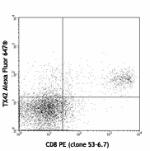
C57BL/6 splenocytes stained with TX42 Alexa Fluor® 647 (uppe... 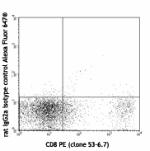
-
Brilliant Violet 510™ anti-mouse CD226 (DNAM-1)

C57BL/6 splenocytes were stained with CD8 FITC and with TX42... 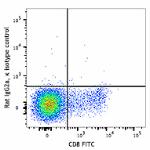
-
Brilliant Violet 650™ anti-mouse CD226 (DNAM-1)
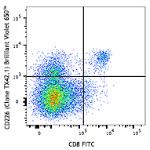
C57BL/6 mouse splenocytes were stained with CD8 FITC and CD2... 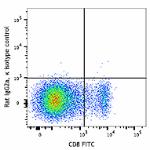
-
Brilliant Violet 421™ anti-mouse CD226 (DNAM-1)
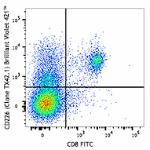
C57BL/6 mouse splenocytes were stained with CD8 FITC and CD2... 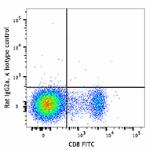
-
Brilliant Violet 711™ anti-mouse CD226 (DNAM-1)
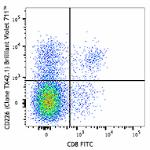
C57BL/6 splenocytes were stained with CD8 FITC and with TX42... 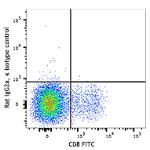
-
Brilliant Violet 605™ anti-mouse CD226 (DNAM-1)

C57BL/6 mouse splenocytes were stained with CD8 FITC and CD2... 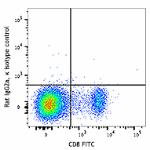
-
Brilliant Violet 785™ anti-mouse CD226 (DNAM-1)
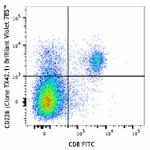
C57BL/6 mouse splenocytes were stained with CD8 FITC and CD2... 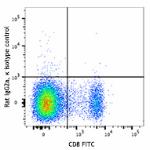
-
PE/Dazzle™ 594 anti-mouse CD226 (DNAM-1)
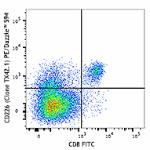
C57BL/6 mouse splenocytes were stained with CD8 FITC and CD2... 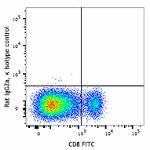
-
PerCP/Cyanine5.5 anti-mouse CD226 (DNAM-1)

C57BL/6 mouse splenocytes were stained with CD8 FITC and CD2... -
APC anti-mouse CD226 (DNAM-1)
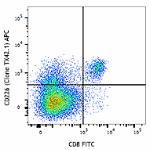
C57BL/6 mouse splenocytes were stained with CD8 FITC and CD2... 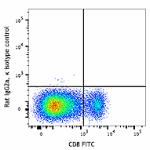
-
Biotin anti-mouse CD226 (DNAM-1)

C57BL/6 mouse splenocytes were stained with CD8 FITC and bio... 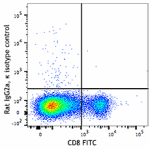
-
PE/Cyanine7 anti-mouse CD226 (DNAM-1)

C57BL/6 mouse splenocytes were stained with CD8 FITC and CD2... -
Purified anti-mouse CD226 (DNAM-1)

C57BL/6 mouse splenocytes were stained with CD8b.2 APC and p... 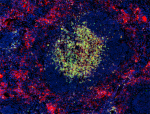
C57BL/6 mouse frozen spleen section was fixed with 4% parafo... -
TotalSeq™-C0949 anti-mouse CD226 (DNAM-1)
-
TotalSeq™-A0949 anti-mouse CD226 (DNAM-1)
 Login / Register
Login / Register 











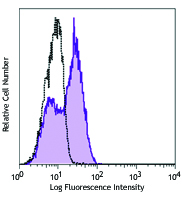
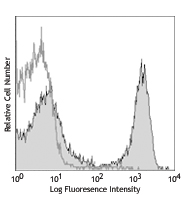




Follow Us